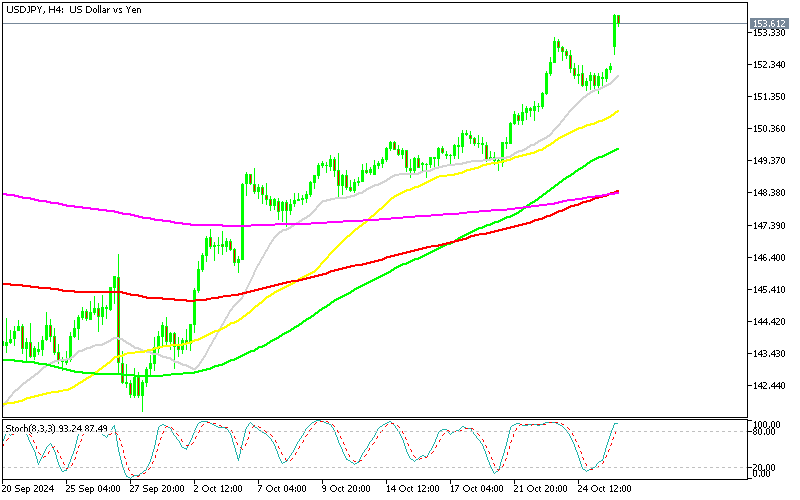USDJPY has shown immense volatility lately, induced by the USD and by the safe haven status, as well as from events in Japan. The Bank of Japan has intervened in the markets throughout this year, both verbally and by force of action, with politics also having their say in all this, so the general elections in Japan hold interest for currency investors and forex traders.

In October, increased USD buying drove the USD/JPY pair up nearly 12 cents, reaching 153. The strong bullish momentum was supported by key moving averages, particularly the 50 and 20 SMAs on the H4 chart. In response, BOJ Governor Ueda issued assertive statements, going beyond typical inflation targets to back the yen, while Finance Minister Kato and other Japanese officials also expressed concerns over the yen’s heightened volatility.
USD/JPY Chart H4 – MAs Keeping the Price Supported
Last weekend, profit-taking on long positions in anticipation of the upcoming Japanese elections contributed to a USD/JPY decline following the strong upward surge. However the 20 SMA (gray) held as support and toward the end of the trading week we saw a bullish reversal.
Japan’s Snap Election for the House of Representatives
On Sunday, Japan held general elections to fill all 465 seats in the House of Representatives. A minimum of 233 seats is needed for a majority.
Background and Key Parties In Japanese Elections
- Prime Minister’s Decision: PM Ishiba called for this snap election just one month after defeating former PM Kishida in the Liberal Democratic Party (LDP) leadership race.
- Current LDP Standing: The LDP, with 247 seats, holds an absolute majority with the support of the Komeito party, which has 32 seats.
- Main Opposing Parties:
- Constitutional Democratic Party (CDP): Led by former PM Yoshihiko Noda, the CDP is the main opposition party with 96 seats.
- Japan Innovation Party (Ishin): Led by Nobuyuki Baba, Ishin is the third-largest party.
Polls and Potential Outcomes
- Polling Insights: Recent polls indicate the LDP may lose its parliamentary majority, suggesting PM Ishiba’s snap election decision may have been risky.
- Strategic Moves:
- Coalition Options: Should the LDP and Komeito fall short of the 233-seat threshold, they may seek additional support from independent candidates or consider partnerships with smaller parties.
- Broader Coalition Possibilities: A larger alliance with Ishin or other minor parties, such as the Democratic Party for the People (DPP), could be explored, but this would require flexibility from the LDP on various policy positions.
Economic and Market Implications from Elections
- Monetary Policy Impact:
- LDP-Led Outcome: If the LDP retains power, either independently or through a coalition, the market reaction remains uncertain. Although PM Ishiba had previously suggested reversing Abenomics, he recently hinted at maintaining current policies after discussions with Bank of Japan (BoJ) Governor Ueda.
- CDP Victory Scenario: A win by the CDP would likely introduce a new government, potentially favoring a more hawkish approach, which could influence BoJ policy and financial markets.
Election Results
Japan’s ruling Liberal Democratic Party (LDP) and its coalition partner Komeito lost their lower house majority, raising the prospect of a minority government. Previously holding 288 seats, the coalition now has only 215—below the 233 needed for a majority. The opposition Constitutional Democratic Party (CDP) made significant gains, growing from 91 to 148 seats.
Smaller parties like the Democratic Party for the People (DPP) with 28 seats and Nippon Ishin no Kai with 38 could join the LDP-Komeito coalition to reach the 233-seat threshold, though a third party may also be needed. Concerns over BOJ policy normalization have impacted the yen, as coalition negotiations could slow rate hikes. Cost-of-living issues and recent LDP funding scandals have also intensified the political landscape, with new coalition partners possibly pushing for either delays or support for BOJ rate increases.
USD/JPY Live Chart
USD/JPY




